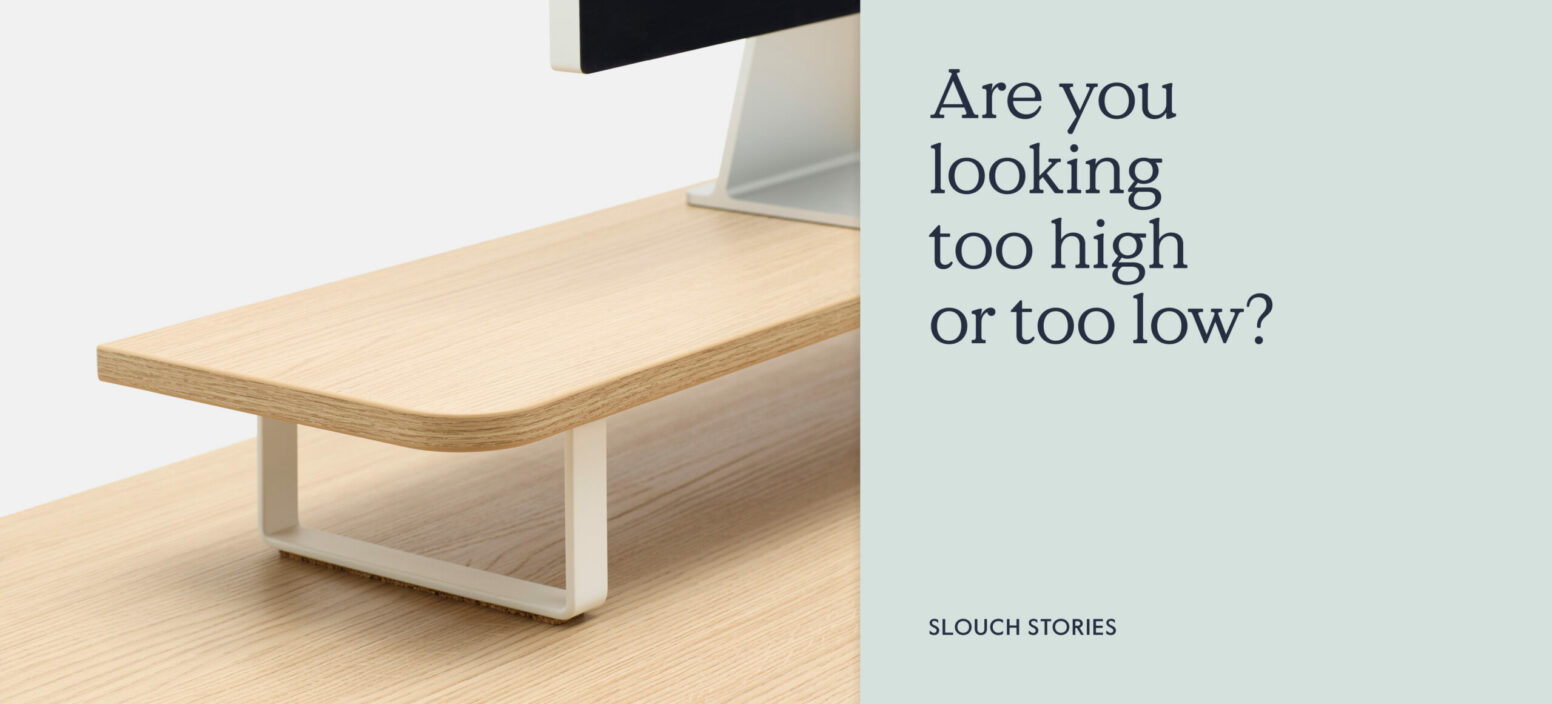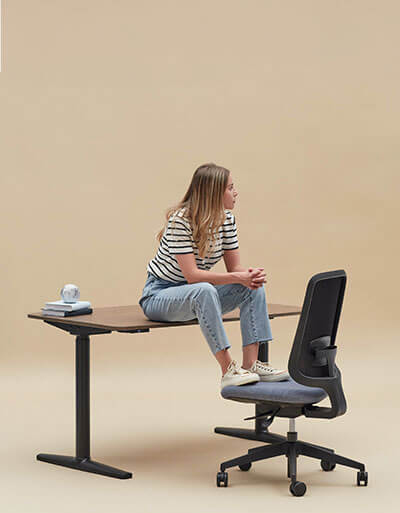Do you get persistent neck ache after a long day at your desk? Or maybe your eyes feel sore even though you’re wearing your glasses? Your monitor height might be the culprit.
At Slouch, we understand the power that making seemingly small changes to your work environment can have a big effect on your body. The difference between a sore neck and a distracted day, really could be as simple as a monitor stand. Let’s get into it.
What is the ideal monitor height?
Here’s the simple answer: the top of your screen should sit at or slightly below your eye level when you’re sitting up straight. This keeps your neck in a neutral position without any awkward tilting up or straining down.
And how far away should it be? About an arm’s length (70 – 80 cm) from your eyes. This is what the Health and Safety Executive recommends for preventing eye strain and encouraging proper posture.
Here’s how to see if your setup is correct:
- Sit up straight with your feet flat on the floor
- Look straight ahead with your chin level
- The top of your screen should line up with your eye level or sit just below it
- Your screen should be an arm’s length away
- You shouldn’t need to tilt your head or strain your eyes to see clearly
Too high and you’ll tilt your head back, straining your neck. Too low and you’ll bend your neck down, causing that notorious ‘tech neck’ posture. Too far away and you’ll find yourself leaning forward and squinting at the screen. So it’s definitely worth taking the time to find the right position for your body.
Want more details on getting your setup right? Watch HSE’s video tutorial below.
Why does monitor height matter?
Getting the correct monitor height right for you is a big part of workplace ergonomics. In other words, ensuring that your setup works with your body instead of causing discomfort, strain or pain. In an ergonomic environment, you can relax and do your best work. In an unergonomic one, your body suffers. Here’s how getting the right screen height helps specifically…
It saves your neck
Your head weighs about 5kg, approximately the same weight as a bowling ball. When you tilt it forward to look at a low screen, your neck muscles have to work up to 5 times harder to support it. So it’s no wonder if you feel a bit sore after a day of poor screen positioning!
In the same vein, a monitor positioned too high forces you to tilt your head backwards, creating a different kind of tension in your neck and shoulders. Either way, it’s not good news for your neck
It’s better for your eyes
When your screen sits at the right height and distance, your eyes can rest in their natural, slightly downward gaze. This helps prevent dry, irritated eyes after a long day.
Science backs this up: looking slightly downward (about 15-20 degrees) reduces the surface area of your eyes exposed to air, which helps prevent them from getting dry and irritated. It also means your eyes don’t have to work as hard to stay focused all day.
It improves your overall posture
Your monitor height doesn’t just affect your neck – it influences your entire sitting posture. When your screen is awkwardly positioned, you’ll make unconscious adjustments – leaning forward, hunching your shoulders, or slouching in your chair.
By getting your monitor height right, you set yourself up for better posture throughout the day, which benefits everything from your spine to your breathing.
How to adjust your monitor height
Now that you know why it matters, let’s look at how to fix your setup.
Use a monitor stand or arm
The easiest solution is a dedicated monitor riser or arm. These let you position your screen exactly where you need it, and often come with bonus features like tilt, swivel, and rotation options.
Monitor arms attach to your desk and offer dynamic adjustments – perfect if you switch between sitting and standing or share your workspace with others who might be taller or shorter than you.
Monitor stands offer a simpler, fixed solution. They lift your screen to a specific height and sometimes include handy storage space underneath – a win for both ergonomics and desk organisation.
Different monitor sizes need different setups
Your monitor size affects the ideal height and distance:
- Larger monitors (27″ and above) might need to sit slightly lower to keep the centre in your comfortable viewing zone
- 24-inch monitors: aim for 50-70 cm away from your eyes
- 27-inch monitors: try 60-80 cm away
- Larger monitors: sit a bit further back for comfortable viewing
Tip: If you’re squinting to read text, don’t move your monitor closer – instead, bump up the text size in your settings. Your eyes will be much happier this way!
Getting the angle right
Did you know your eyes naturally prefer to look slightly downward when at rest? Help them out by tilting your monitor back slightly, about 10-20 degrees from vertical.
This subtle adjustment works with your natural gaze pattern and can help reduce annoying glare from overhead lighting – win-win.
If you wear glasses with bifocals or progressive lenses, you might need a more pronounced tilt (around 30 degrees) and a slightly lower monitor position to work with the reading portion of your lenses.
What about laptops?
Laptops are ideal for portability, but often not the best for ergonomics. The screen and keyboard are permanently attached, so when the keyboard is at a comfortable typing height, the screen is way too low, and vice versa.
One good solution could be to add in an external keyboard and mouse. That frees you to raise your laptop on a monitor riser to the perfect viewing height while keeping your hands and wrists in a comfortable typing position.
Trust us, a decent laptop stand and separate peripherals are worth every penny if you regularly work on a laptop. Your body will notice the difference almost immediately.
How does screen height work for standing desks?
If you’re using a height-adjustable desk, remember that your monitor height needs to change when you switch between sitting and standing. Your eye level shoots up significantly when you stand, so your monitor should rise accordingly.
Ideally, invest in an adjustable monitor arm that can move with you as you transition between positions. This ensures you maintain proper ergonomics regardless of whether you’re sitting or standing.
Signs your monitor height needs fixing
Not sure if your current setup is causing problems? Watch for these warning signs:
- Persistent neck pain or stiffness after work
- Headaches that develop during or after screen time
- Dry, irritated eyes that feel worse as the day progresses
- Tension building across your shoulders
- Finding yourself gradually hunching forward or slouching
If any of these sound familiar, it might be time to reassess your monitor height and overall desk setup.
Create your perfect Slouch workspace
For the ultimate setup, pair a Slouch desk and chair with a quality monitor stand or arm that lets you position your screen at the perfect height for a bespoke home office setup.
Ready for a more comfortable workday? Explore our range of ergonomic office furniture designed to keep you comfortable all day long.
Email us at [email protected] with any questions you might have – we’re always happy to help.

